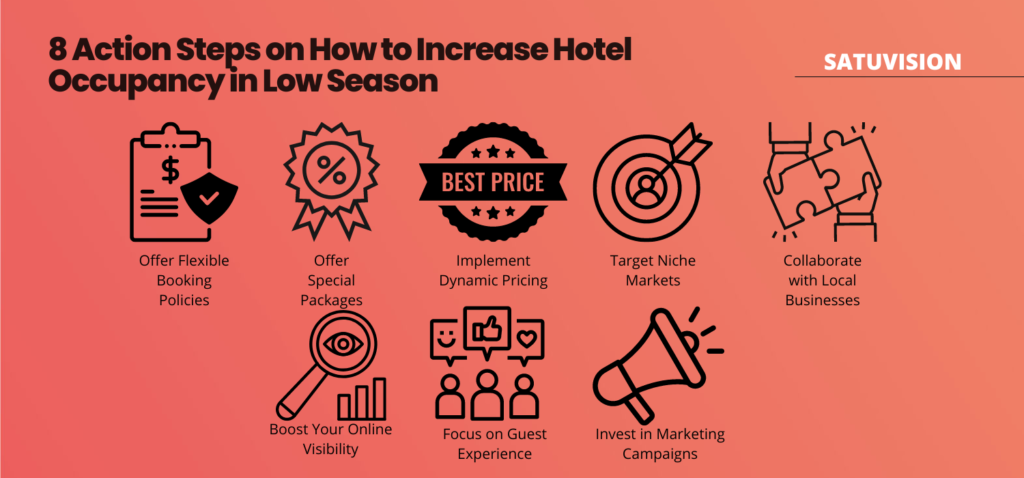Adapting and Thriving: How to Increase Hotel Occupancy in Low Season
You know for sure there’s a time called low season in this industry. No matter what, running a hospitality business means facing this situation. And adaptation is the key. During low season, you can adapt by implementing flexible booking policies, offering special packages, or targeting a niche market. Let’s learn more about how to increase hotel occupancy in the low season and maximize revenue during off-peak times.
Table of Contents
When is the Low Season in Bali?
The low season typically happens from late February to late March. To cope with the low season in Bali, you need to adjust your strategies. A report from The Bali Central Statistics Agency shows that the low season for visitors to Bali is from January to March. In this case, you should take steps to adapt during the low season and prepare for the peak season.
Here are eight strategies to increase hotel occupancy during the low season in Bali.
8 Actionable Steps on How to Increase Hotel Occupancy in Low Season

Offer Flexible Booking Policies
Provide flexible booking options, such as free cancellations or date changes, to accommodate concerns and encourage travelers to book their stay.
- Understanding Demand for Flexibility: A survey shows that 76% of guests value flexible cancellation and refund policies.
- Proven Results: Booking.com research indicates that listings with free cancellation see a 3% increase in conversion rates, suggesting that flexibility can significantly impact booking behaviors.
- Benefits of Flexible Policies: You can enhance customer satisfaction, provide a competitive edge, and increase occupancy rates during off-peak times.
Offer Special Packages
Create interesting packages with discounted rates, complimentary services, or added-value amenities to attract guests during off-peak times.
Tailored Deals for Low Season
During the low season months, crafting special packages like “stay longer, pay less” can transform occupancy rates:
- Creating Value: Packages that offer more for less appeal to guests looking for value, encouraging longer stays and greater spending at the hotel.
- Seasonal Strategy: Use the low season’s unique quietude to offer relaxing, value-packed deals that attract visitors.
Implement Dynamic Pricing
Use dynamic pricing strategies to adjust room rates based on demand fluctuations, ensuring competitive pricing during slow periods.
- Demand-Based Pricing: Lower rates during the low season can attract budget-conscious travelers, boosting occupancy.
- Customized Rates: Adjust prices for different guest types to maximize revenue and occupancy year-round.
- For instance, a hotel might lower its standard rate by 20% in the quieter season to attract budget-minded travelers, thus improving its occupancy rates during a typically slower period.
Target Niche Markets
Focusing on Niche Guests
Identify and cater to niche markets like business travelers, eco-tourists, or wellness enthusiasts during the off-season:
- Tailored Promotions: Develop marketing campaigns that speak directly to the interests and needs of these groups.
- Enhanced Guest Experience: Offer specialized amenities and services that make your hotel the preferred choice for these travelers.
Collaborate with Local Businesses
Do you know that today is the era of collaboration? The era of collaboration refers to a business trend where companies collaborate to find innovative solutions and build a more sustainable future.
Partnerships That Enrich Guest Experience
Collaborate with local entities to offer comprehensive experiences:
- Bundled Offers: Package deals with local attractions enhance your hotel’s value and attractiveness.
- Community Engagement: Sharing resources and insights with local businesses can lead to innovative offerings that enhance the guest experience.
Boost Your Online Visibility

Maximizing Seasonal Preparations
According to Google research, 65% of leisure travelers and 69% of business travelers initiate their hotel searches using a search engine. Optimizing your online presence is crucial for capturing the attention of potential guests, especially during the planning phase of their travels:
- SEO Strategies: Enhance your website and social media profiles for better search engine visibility.
- Data-Driven Insights: According to Google, most travelers start their hotel searches online, making your digital presence critical to attracting bookings.
Focus on Guest Experience
Personalizing Hotel Stays to Enhance Guest Satisfaction
High Demand for Personalization: 80% of travelers prefer hotels that offer personalized experiences.
Key Strategies:
- Customized Services: Tailor services like room settings and dining options to individual tastes.
- Personal Recommendations: Offer insights and suggestions tailored to guest interests.
- Unique Amenities: Provide special amenities that cater specifically to guest preferences.
Benefits:
- Repeat Business: Personalized experiences encourage guests to return.
- Positive Reviews: Increases the likelihood of positive feedback, enhancing reputation.
Invest in Marketing Campaigns
Effective Marketing to Increase Occupancy
Utilize a targeted, multi-channel marketing approach during low seasons to maintain high occupancy:
- Digital Advertising: Target specific guest demographics on platforms like Google Ads and social media.
- Email Newsletters: Keep your hotel in mind with regular updates and exclusive offers.
- Travel Platforms: Collaborate with travel booking sites to highlight unique selling points and seasonal promotions.
Example:
A couple receives a personalized email promoting a “romantic summer retreat” with spa services and a gourmet dinner, leading them to book a weekend stay.
Read also: Hotel Marketing Strategy to Increase Occupancy
Conclusion
Adapting to low seasons is crucial for hotels to thrive. By offering flexible booking, special packages, and dynamic pricing, hotels can attract guests during the low season. Targeting niche markets, collaborating locally, and boosting online visibility are effective strategies. Focusing on guest experience and investing in marketing campaigns further enhance occupancy rates. With these approaches, you can navigate low seasons successfully and ensure continued prosperity in the hospitality industry.
Frequently Asked Questions
Seasonal changes and holiday periods significantly impact hotel occupancy rates. This is crucial information for business travelers, as accommodations’ pricing and availability vary widely across the high, shoulder, and low seasons.
The term “high season” or “peak season” refers to when tourism is at its highest, attracting the most visitors. Conversely, the “low season” or “off season” represents the period when tourism is minimal. Climate is often a key factor in determining the off-season for a particular city or region.





